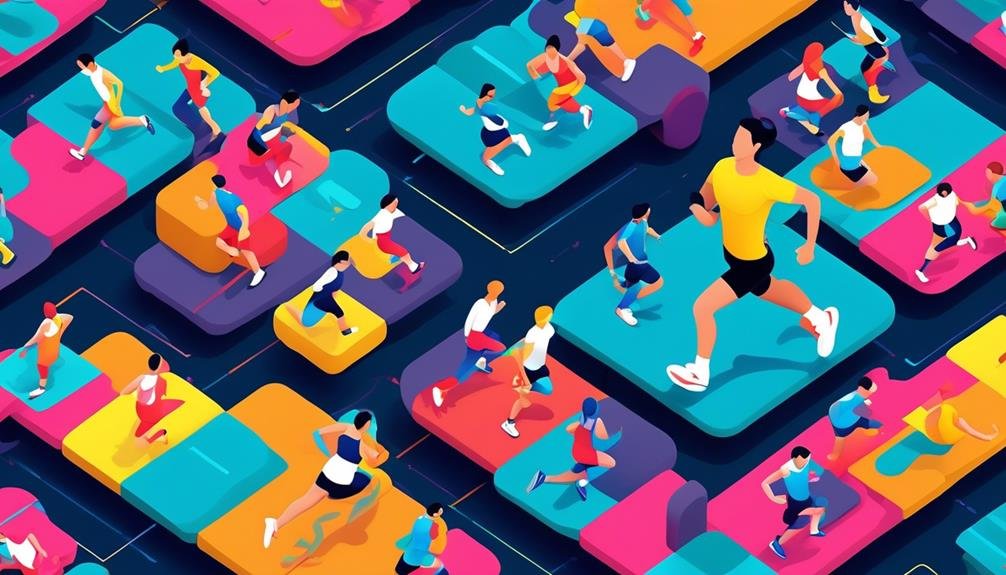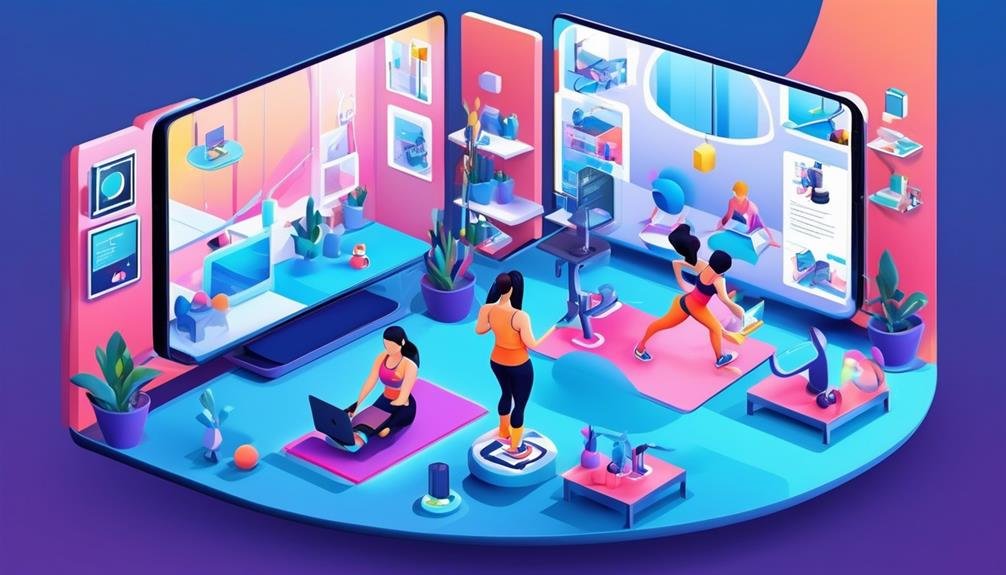Imagine you're a sailor lost at sea, navigating through treacherous waters without the help of a compass or a crew. Just as you rely on your fellow sailors to guide you through the storm, having training partners can provide motivation, accountability, and support during your fitness journey.
But what happens when those partners aren't available? How do you modify your workouts to keep progressing towards your goals? In this discussion, we'll explore various strategies and tips to help you navigate these uncharted waters, ensuring that you stay on course and continue on your path to success.
Key Takeaways
- Incorporate solo-friendly exercises such as bodyweight exercises, resistance bands, and cardio activities.
- Utilize alternative equipment or methods like dynamic movements, suspension trainers, and plyometric exercises.
- Implement interval training techniques by incorporating high-intensity intervals and modifying rest intervals.
- Focus on individual goals and progress tracking by implementing a tracking system, regularly assessing performance, and seeking guidance and support from online resources and communities.
Adjusting Workout Intensity
To adjust the intensity of your workout, you have several options at your disposal. By making changes to the number of sets and reps, you can tailor your training to meet your specific goals. Increasing the number of sets and reps can push you to new limits, while decreasing them can allow for recovery and prevent overexertion.
Another way to modify your workout is by adjusting the rest periods between exercises. Shortening the rest periods can make your workout more challenging and increase the intensity, while lengthening them can provide more recovery time and help manage fatigue.
In addition to sets, reps, and rest periods, you can also adjust the resistance levels to alter the difficulty of your workout. This can be done by using heavier weights to increase intensity or lighter weights to focus on proper form and technique.
Modifying Exercise Selection
Incorporate a variety of exercises into your workout routine to keep it fresh and challenging, regardless of whether you have training partners or not. Modifying exercise selection is an essential aspect of adapting your training plan to solo workouts.
Here are some effective strategies to modify your exercise selection:
- Consider bodyweight exercises that can be challenging even without equipment. Exercises like push-ups, squats, lunges, and planks can target multiple muscle groups and provide a great workout on their own.
- Modify partner exercises to be performed solo. For example, if you usually do partner sit-ups, you can switch to Russian twists or bicycle crunches to engage your core muscles effectively.
- Incorporate resistance bands or medicine balls into your routine. These versatile tools can add intensity and variety to your exercises. Use resistance bands for exercises like bicep curls or lateral raises, and incorporate medicine balls for exercises like wall balls or medicine ball slams.
Incorporating Solo-Friendly Exercises

Incorporating solo-friendly exercises into your workout routine is a fantastic way to stay active and motivated, even without a training partner. When modifying your workouts, there are plenty of options available that don't require a partner.
Bodyweight exercises, such as push-ups, squats, and lunges, can be done anywhere and are effective for building strength and endurance. Resistance bands are another great tool for solo workouts, allowing you to target specific muscle groups and increase resistance as you progress.
For cardio, activities like running, cycling, or swimming can be enjoyed independently, giving you the freedom to set your own pace and challenge yourself.
Don't forget about flexibility and mobility exercises, which can be done solo and are essential for maintaining a balanced workout routine. Yoga and Pilates are excellent choices for improving flexibility and core strength.
If you're looking for a change of scenery, consider solo-friendly activities like hiking, climbing, or outdoor sports. These not only provide a great workout but also allow you to connect with nature and enjoy some solitude.
Utilizing Alternative Equipment or Methods
Keep your workouts challenging and engaging by exploring alternative equipment or methods that can be used in solo workouts. While training partners can provide motivation and accountability, there are still plenty of options available to keep you on track towards your fitness goals. Here are some alternative equipment and methods that you can incorporate into your solo workouts:
- Bodyweight exercises: Utilize your own body weight to create challenging workouts without the need for any equipment. Exercises like push-ups, squats, and burpees can effectively target multiple muscle groups and increase your heart rate.
- Resistance bands: These versatile bands can provide resistance for strength training exercises such as woodchops, rows, and chest presses. They're lightweight and portable, making them a convenient option for solo workouts.
- Dynamic movements: Explore a variety of squats, lunges, deadlifts, hip thrusts, and calf raises to target different muscle groups and movement patterns. These exercises can be performed using just your body weight or with added resistance from dumbbells or kettlebells.
Implementing Interval Training Techniques

Elevate your solo workouts to new levels of intensity and efficiency by implementing interval training techniques.
When you don't have a training partner, interval training can be a game-changer. By varying exercise intensity and duration, you can maximize your workout and achieve better results on your own.
One way to do this is by incorporating high-intensity intervals. Whether it's sprinting or performing fast-paced bodyweight exercises, these bursts of intense effort will elevate your heart rate and challenge your body.
Another effective method is using timed intervals for both cardio and strength exercises. Alternate between periods of high-intensity effort and active recovery to simulate partner-based workouts. This keeps you engaged and focused, pushing yourself to the limit.
Don't forget to modify your rest intervals between sets and exercises. By reducing the rest time, you maintain the intensity and keep your muscles engaged.
Remember, modifying your workouts is all about personal progress and preferences. So, experiment with different interval lengths and exercises to find what works best for you.
Implementing interval training techniques is a surefire way to modify your workouts and make the most out of your solo training sessions.
Focusing on Individual Goals and Progress Tracking
To truly excel in your solo workouts, it's crucial to focus on your individual goals and track your progress along the way. By setting clear, personalized goals, you can tailor your workouts to meet your specific needs and aspirations.
Here are three key steps to help you stay on track and make the most of your individual training journey:
- Implement a tracking system: Whether it's a workout journal or a fitness app, monitoring your progress is essential. Keep track of your workouts, exercises, weights, and repetitions. This will allow you to see your improvements over time and make adjustments to your workouts as needed.
- Regularly assess your performance: Take the time to evaluate your progress and adjust your training plan accordingly. Listen to your body and pay attention to any feedback it gives you. If you notice areas where you need improvement, make the necessary adjustments to your workouts to address those areas.
- Seek guidance and support: While you may not have training partners physically present, you can still tap into online resources and virtual fitness communities. These platforms can provide the guidance, motivation, and support you need to stay motivated and achieve your individual fitness goals.
Seeking Virtual or Online Training Resources

To enhance your solo workouts and make the most of your training journey, explore the vast array of virtual or online training resources available to you. In today's digital age, there are countless platforms and apps that offer guided workouts and coaching, making it easier than ever to stay motivated and challenged. Whether you're looking for structured exercise routines, personalized training plans, or virtual support and accountability, there are options for everyone.
Consider utilizing online resources such as workout videos, live stream classes, and fitness apps. These tools provide a wide range of workouts that you can do in the comfort of your own home or anywhere you have an internet connection. They offer the convenience of having a professional trainer guide you through exercises and provide modifications when needed.
Joining online fitness communities or forums can also be beneficial. These platforms allow you to connect with like-minded individuals who share similar goals and can provide virtual support and motivation. Through these communities, you can exchange tips, share progress, and find inspiration to keep pushing yourself.
If you're looking for more personalized guidance, you may want to consider hiring a virtual personal trainer. These professionals can create individualized workout plans tailored to your specific needs, provide ongoing support and feedback, and help you stay accountable to your fitness goals.
Lastly, don't underestimate the power of virtual training sessions with a friend or family member. While they may not physically be by your side, scheduling regular virtual workouts with a training partner can help maintain a sense of camaraderie and motivation. You can challenge and encourage each other, making your solo workouts feel more like a team effort.
To summarize, seeking virtual or online training resources can be a game-changer for your solo workouts. From guided workouts to personalized training plans and virtual support, these resources offer a wealth of options to keep you motivated and on track. Embrace the digital world and take advantage of the tools available to enhance your training journey.
Frequently Asked Questions
What to Do if You Don't Have a Gym Partner?
If you don't have a gym partner, don't worry! You can modify your workouts by incorporating habit stacking, setting timers, clarifying intentions, eliminating distractions, and dedicating energy to one goal at a time. Keep pushing yourself!
How to Get the Most Out of Your Workouts if You Don T Have a Trainer?
You can still maximize your workouts without a trainer. Focus on your goals, adjust training plans to fit your needs, and find alternative exercises that challenge you. Stay consistent and motivated, and you'll see progress.
How Do You Edit a Workout on Fitness?
You can modify your workouts when training partners aren't available by adjusting the duration, intensity, or number of intervals. Prioritize consistency and consider engaging in activities that promote recovery. Keep pushing yourself while ensuring you don't overtrain.
How Do I Change My Workout Program?
To change your workout program when training partners aren't available, focus on solo exercises like bodyweight movements or resistance bands. Pair them with existing routines to build consistency and set specific goals to stay motivated. Consider virtual workout partners or online communities for support.
Conclusion
In conclusion, when training partners aren't available, it's important to adapt and modify your workouts to meet your individual needs.
By adjusting the intensity, incorporating solo-friendly exercises, and utilizing alternative methods, you can continue to progress towards your fitness goals.
Remember, even though it may be challenging at times, staying motivated and focused on your own progress will ultimately lead to success.
Keep pushing yourself and never underestimate the power of your own determination.
You've got this!
